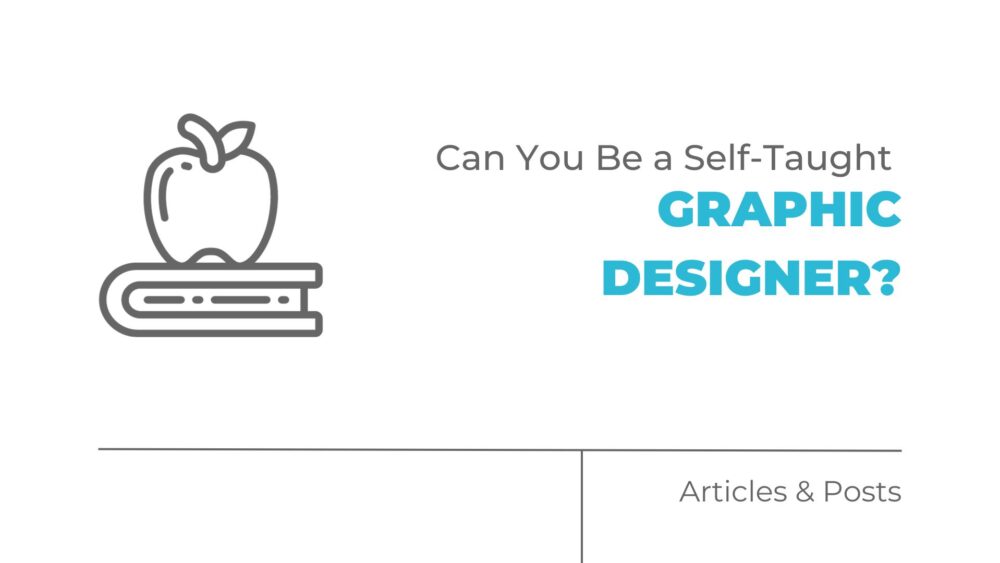Are you passionate about graphic design and creativity?
Do you have a natural talent for visual aesthetics?
If so, you may be wondering if it’s possible to become a self-taught graphic designer.
The answer is actually No.
You can’t teach yourself something you don’t know how to do.
What you CAN do is choose to be a learner whether you have a degree or not.
While going to a university and getting a degree in graphic design can provide a solid foundation, it’s not the only path to career success in this industry.
While the majority of working graphic designers are not solely self-taught, you don’t need a formal education to start a graphic design career.
Many great graphic designers have achieved greatness without ever stepping foot inside a classroom.
So yes—it can definitely be done!
So, let’s look at what the possibilities of becoming a self-taught graphic designer.
Who are some famous self-taught graphic designers?
Do you have to go to design school?
No—it’s not absolutely necessary to go to design school.
Here’s why:
There have been some famous “self-taught” (what we really mean is they are chose to learn outside of a school) graphic designers who have left an indelible mark on the industry of graphic design.
Here are some of our favorite here at MOCK, the Agency.
David Carson
David Carson, a prominent contemporary graphic designer and art director, is known for his unconventional and experimental graphic style that revolutionized the field.
Surprisingly, David Carson did not receive a formal education in design.
Instead, he pursued a degree in sociology.
However, his passion for surfing played a significant role in shaping his artistic journey and and career.
Without the traditional training of a design school, Carson relied on his intuition, personal experiences, and continuous experimentation to refine his skills.
He chose to take steps to learn and grow to constantly improve.
He embraced the freedom to break established rules and pushed the boundaries of graphic design, creating visually captivating and thought-provoking pieces.
Paul Rand
Rand, renowned for designing iconic logos like IBM and ABC, honed his skills through self-study and a deep passion for design.
He was largely self-taught and had a great creative talent for visual communication.
Rand’s dedication to learning and experimentation allowed him to develop his skills and create a distinct style that would make him an influential figure in graphic design.
Through his extensive personal studies and exploration of design principles, Rand honed his craft.
He drew inspiration from various sources, including modernist movements and the works of artists such as Piet Mondrian and El Lissitzky.
Rand also immersed himself in the world of advertising and typography, constantly seeking new techniques and approaches to deliver impactful designs.
Saul Bass
Saul Bass, an American graphic designer and Oscar-winning filmmaker, is celebrated for his iconic contributions to the world of design.
He gained recognition for his innovative motion-picture title sequences, film posters, and corporate logos.
Despite not receiving formal education in graphic design, Bass taught himself through self-study and experimentation.
His relentless pursuit of knowledge and exploration of design principles allowed him to develop a distinct style that resonated with audiences.
Bass’s ability to distill complex messages into simple yet impactful creative designs became his trademark.
His work, which includes memorable title sequences for films like “North by Northwest” and “Anatomy of a Murder,” that were significant in his career.
Today, Saul Bass is regarded as one of the greatest graphic designers of the 20th century, his influence continuing to inspire designers worldwide.
Where can I start to learn graphic design?
Let’s explore the resources available to help you learn graphic design on your own.
Here are some things you can do to start off on the right foot:

Online tutorials and courses about color and more
Online tutorials and courses present a great opportunity for education with the fundamentals of color theory and design.
Platforms such as Coursera, Udemy, and Skillshare offer comprehensive courses where graphic design professionals share their knowledge and insights.
They cover a range of topics from the basics of color theory, understanding color harmony, the psychology of color, to practical applications in design.
These courses often include assignments and practical projects that will help you apply what you learn in real-world scenarios.
Regularly engaging with these materials can significantly enrich your graphic design capabilities and enable you to create visually appealing and impactful designs.
YouTube tutorials to flow with the pros
YouTube constitutes an invaluable education resource for aspiring graphic designers.
Why?
It’s home to a plethora of professional designers who share their expertise and design processes with the global community.
Channels such as The Futur, Satori Graphics, and Photoshop Training Channel offer insightful tutorials, design critiques, and career advice for budding designers.
They delve into the nitty-gritty of graphic design concepts, software tricks, and graphic trends.
Their interactive formats often allow for questions and discourse, fostering a virtual classroom environment.
By subscribing to these channels and consistently following their content, you get exposed to diverse design approaches and techniques, helping you refine your craft and keep up with industry dynamics.
Online design communities
Joining online graphic design communities, such as Dribbble and Behance, exposes you to a wealth of inspiration, education, and feedback from fellow designers.
Engaging with these communities can accelerate your growth and provide valuable networking opportunities.
Remember, learning graphic design is an ongoing process.
Embrace the mindset of continuous creative improvement, always seeking new knowledge and refining your skills.
With determination and the right resources, you can make your way toward a good career as a self-taught graphic designer.
So why wait?
Start your journey now!
How to become a graphic designer without a degree: Practical Steps and Vital Information
Now, here’s how to become a self taught graphic designer.
We don’t really mean teach yourself.
You can’t teach anything you don’t already know how to do.
What you can do is position yourself so you will learn and become good at this new job.
1.Learning: Build a strong foundation
The essence of becoming a successful self-taught graphic designer lies in being an eternal student.
Having a proactive and inquisitive attitude is critical to your growth journey.
Merely understanding the basics of graphic design is not enough, the great challenge is in applying this knowledge creatively to solve problems.
This is where continuous learning and practicing come into play.
As technology and trends rapidly evolve, you need to be in a constant state of adapting and mastering new skills.
This includes understanding new design software, being aware of emerging graphic design trends, and continuously improving your own design aesthetic.
Always remember – every design you create adds to your portfolio, and each one is a learning experience that brings you one step closer to mastery.

2.Practice, practice, practice
Design is a hands-on field, so dedicate time to practice creative skills regularly.
It’s the only way to really get good at something – keep learning and practicing with the goal of getting better.
Challenge yourself with real-world projects, experiment with different graphic design styles, and seek feedback from other designers to refine your skills.
3.Master design software
Software such as Adobe Illustrator, Photoshop, and InDesign offer a broad spectrum of features that allow you to bring your creative ideas to life.
They come packed with a myriad of tools, effects, and filters that can dramatically transform your designs and create stunning visuals.
Learning these software applications enables you to manipulate images, create and edit vector graphics, layout pages, and so much more.
As you develop proficiency in these programs, you can experiment with different creative techniques and effects, pushing the boundaries of your graphic design capabilities.
This proficiency not only helps in creating a great portfolio but also opens up opportunities to work on diverse design projects, thereby further honing your skills.
3.Build a portfolio
As a self-taught designer, your portfolio serves as your calling card.
It showcases your capabilities, design aesthetic, and areas of expertise.
This is a critical tool when it comes to applying for graphic design roles or attracting clients as a freelancer.
Start by selecting your best work across different mediums and compile them in an online portfolio or website.
Ensure the pieces you include in your design portfolio are good, high-quality, and well-presented.
As you continue to create new designs, update your portfolio regularly to showcase your progress and growth.
Showcase your best work, demonstrate your range of skills, and highlight any relevant projects or collaborations you’ve been a part of.
Your portfolio is your chance to make a strong first impression on potential clients or employers, so be sure to present it in the most visually appealing and professional manner.

4.Network and seek mentorship
Online and in-person networking and mentorship play integral roles in your journey to becoming a sought-after graphic designer for brand and graphic design jobs.
Engaging with graphic design professionals and experienced designers through networking can expose you to invaluable insights, opportunities, and inspirations.
It allows you to stay abreast of the latest trends, techniques, and industry standards, further fine-tuning your design skills.
Mentorship, on the other hand, offers personalized guidance, allowing you to learn from the experiences and expertise of established designers.
Mentors can provide constructive criticism, challenge your approach, and foster your growth as a designer.
They can also guide you towards the right opportunities, helping you build a strong reputation in graphic design.
And your reputation is ESSENTIAL in thriving in graphic design.
How do I write a killer self-taught graphic designer bio?
Once you’ve honed your skills and built a portfolio, it’s essential to craft an impressive self-taught graphic designer bio.
This can be for your website or blog, which you’ll also need to create to establish yourself as a professional.
Here are some tips to make it stand out:
Highlight your unique journey
Emphasize your self-taught path and how it has shaped your design perspective.
Share any notable projects or challenges you’ve overcome along the way.
This will showcase your determination and passion for the field, setting you apart from traditionally educated designers.
View your unique journey with confidence, and present it as a positive trait.
Your future clients are like to view you as you see yourself.
Use engaging language
Your bio should be a reflection of your design aesthetic.
If you use concise and impactful language to captivate your audience, you can really showcase your creativity and personality.
Avoid using buzzwords or clichés and instead opt for unique descriptions that truly represent who you are as a designer.

Include your specialties and skills
List your areas of expertise, such as branding, illustration, or web design.
This will help potential clients or employers understand your strengths and determine if you are the right fit for their job.
Highlight any specialized skills or software proficiency that sets you apart from other designers.
Additionally, include any industry recognition, awards, or publications you’ve received.
This adds credibility and says that you are an expert in the field.
Whether it’s logo design, branding, or illustration, let your potential clients or creative agencies know what you excel in.
Include testimonials
If you’ve worked with clients or collaborated with other professionals, include their testimonials in your bio.
These endorsements help people believe that you will deliver exceptional work.
Remember, your bio is your opportunity to leave a lasting impression.
If you make it concise, engaging, and reflective of your unique journey, companies hiring for graphic design jobs will be more likely to be drawn to you.
Use it to showcase your skills, personality, and passion for design.
With practice, dedication, and a strong online presence, you can successfully establish yourself as a sought-after self-taught graphic designer.
Happy designing!
You CAN learn to become a graphic designer even without a formal education in the industry.
With passion, perseverance, and a willingness to learn, you can turn your dreams of becoming a graphic designer into reality – even without a degree in graphic design.
Never stop learning and seek out resources that will help you grow—from tutorials to online communities.
Make sure to document your journey and remember to enjoy the process!

The question of becoming a graphic designer—or any professional for that matter—often boils down to this: “Are you willing to invest the time and effort required to truly excel in your field?”
This is perhaps the most important question you need to ask yourself when considering a career in graphic design.
Graphic design, like any craft, requires dedication, patience, and a continuous desire to learn and improve.
It’s not just about whether you have a knack for aesthetics or you are proficient with Adobe Illustrator and other design software.
Instead, it’s about the persistence to refine your skills, explore new techniques, and adapt to evolving trends.
So, as you ponder over the prospect of being a graphic designer, remember that the pursuit of mastery in this field hinges greatly on your willingness to commit, learn, and grow.
Rome wasn’t built in a day, but it was built.
Graphic designing careers are the same way.
With dedication and hard work, success is truly possible.
You got this!


Comments are closed.